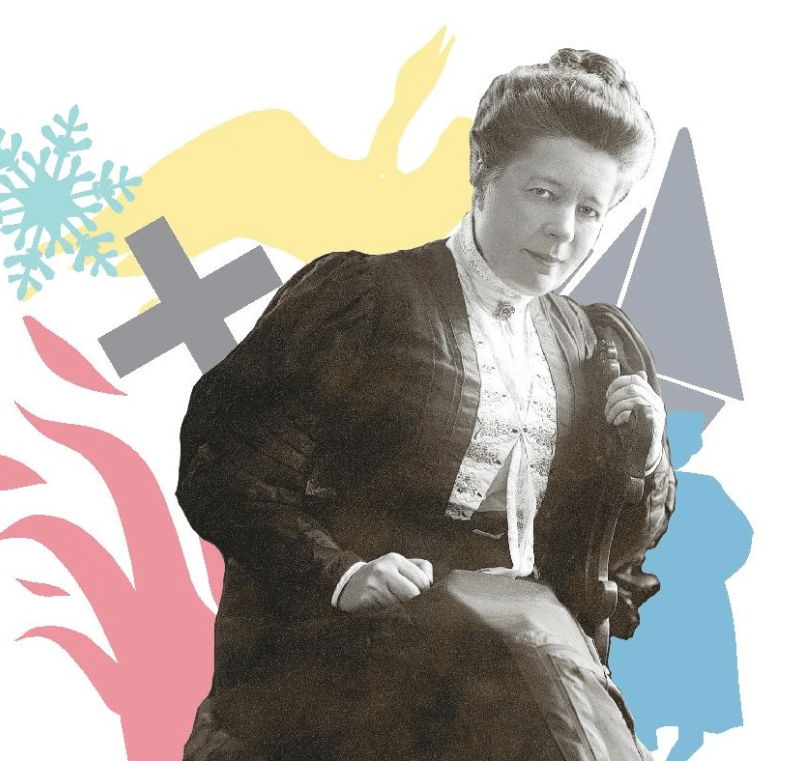
It’s December, and time for our festive blog! We’ve compiled a fireside reading list for you to enjoy this season.
1. A naughty boy learns his lesson – and teaches their lessons to Swedish children.
‘He stared and stared and could not believe his eyes. What at first had seemed to be a shadow became more and more solid and he could soon see that it was something real. Without a shadow of doubt, there was an elf sitting astride the edge of the chest.’
Nils, a fourteen-year-old farmer’s boy, is lazy and unkind. He meets his match when he tries to trick an elf, who shrinks him so that he’s elf-size himself. Trying to stop a farm gander from escaping to join some wild geese, he is whisked into the sky and travels far and wide with the geese, learning kindness as well as geography on the way.
Selma Lagerlöf’s Nils Holgersson’s Wonderful Journey Through Sweden (1906–07, translated by Peter Graves) was written to teach Swedish schoolchildren about the history, topography and culture of their own country. Like the consummate story-teller she is, the author transforms a school textbook into a magical adventure story full of talking animals and mythical battles, in which Nils comes to understand the value of selflessness and compassion.
In a beautifully-produced hardback volume, Bea Bonafini’s quirky illustrations capture the fairy-tale atmosphere.
2. Secrets lurk in the corridors of a Norwegian mountain hotel
‘My mother disappeared early on and is therefore impossible to remember. It seems she was a witch. Not a real witch, of course, but she wanted to be one. That’s what Jim told me, because he knew her. A bit, anyway. He thought it all came from listening too much to that Donovan song ‘Season of the Witch’, and then reading too many weird books about witches, before she made her mind up and set off to find Bloksberg or inner peace and was taken by Time. That’s why I have such a strange first name, Sedgewick, because there was a famous witch whose surname it was, until she was burnt.’
In this novel young Sedgewick, who helps his grandparents to run a splendid and traditional mountain hotel, sets out to find the truth about his origins. His parents have vanished and no-one talks about them. As he slowly uncovers the secrets of his past, he realises that the present holds secrets too – and one of the biggest is that the impressive family hotel is on the brink of bankruptcy. Grandfather is struggling to maintain the façade as matters become more and more desperate, and the secrets of the past and the present collide in a blazing denouement.
In Lobster Life (2016, translated by Janet Garton), Erik Fosnes Hansen looks at life and its challenges from the viewpoint of an adolescent boy, whose seriousness provides much inadvertent humour.
The hotel guests are an eccentric collection of individuals who require special treatment, one of the strangest being the national organization of funeral directors, who hold their annual feast at the hotel and embark on riotous songs to celebrate their achievements:
A timer on a bomb clicked home, a plane fell from the sky
Our Daimler plucked up bodies by the score.
Titanic was a great success, our boat was just nearby
We dived and pulled them out again to bury them once more.
3. The storybook life of the great storyteller
‘If the little ones at Mårbacka had not found out some other way that Christmas was coming, they would certainly have realised when they saw von Wachenfeldt arriving.
And they were beside themselves with glee to see his horse and one-man sleigh at the top of the avenue. They ran all through the house to proclaim the good news, they stood on the front steps to receive him, they shouted good day and welcome, they brought bread for his horse and they carried his meagre carpet bag, embroidered with cross-stitch flowers and leaves, down to the office where the guest was to reside.
It was strange, really, that the children always received Warrant Officer von Wachenfeldt so warmly. They could expect neither sweets nor presents from him but they must have felt he was all part of Christmas, and that was the reason for their delight. At any rate, it was just as well they treated him kindly, for the grown-ups made no fuss of him.’
From the age of three, the little Selma was acutely observant of life at the family estate of Mårbacka; growing up in the 1860s surrounded by the events of the farming year, the eccentric members of her wider family and her lively brothers and sisters, she had in many ways an idyllic childhood. Through her eyes we follow the dramatic events, comical behaviour and, at times, poignantly sad fates of Swedish provincial life, as the skies begin to darken and the very basis of life itself, the family farm, comes under threat.
Selma Lagerlöf has written three autobiographical novels, of which the first two, Mårbacka (1922) and Memoirs of a Child (1930, both translated by Sarah Death) have been published by Norvik Press. They turn her childhood into a story, part autobiography and part myth-making. ‘I can’t do with relying just on my memory, I must have artistic form,’ as the author commented herself.
4. Atmospheric smalltown memories and a mother’s nightmare
‘I’d decided to collect everything that belonged to Elizabeth in one special box. But there was so little that was hers, a thin layer of clothes just covering the bottom and a pair of worn boots, a few bottles and tubes of cheap cosmetics. Nothing she owned seemed to have been particularly affected by having passed through her hands. When she was little I knew every seam of her clothes and every broken edge of her wooden toys. Now I didn’t know her at all.’
Self-questioning Ann-Marie is engulfed by memories and anxieties when she returns to her home town and takes up residence among assorted down-and-out lodgers in the old family home, camping out in its clutter as she tries desperately to track down her missing daughter Elizabeth. She spends a makeshift Christmas with a close family friend, and continues her efforts to make sense of the physical remnants of her father’s life as an inventor, and a drinker. Her mind is a whirl of images of the generations of individuals she has known in the town. A tall man dressed as a magician has arrived on the same train, and as the hunt for Elisabeth intensifies, this close-to-the-bone story of filial frailties and jagged maternal love is deepened by hints of mythology and magical realism.
Kerstin Ekman is acknowledged as a towering figure in contemporary Swedish storytelling. City of Light (1983), a rich and many-layered novel, was translated for Norvik Press by Linda Schenck in 2003. It is the final part in Ekman’s Katrineholm quartet, also known as ‘Women and the City’, a women’s-eye view of the development of a small southern Swedish town, from the coming of the railway through to the 1980s.
If poetry is your bag: dual-language Nordic masters
1. Hans Børli: lumberjack and poet of the Norwegian forests
Vi eier skogene
Jeg har aldri eid et tre.
Ingen av mitt folk
Har noensinne eid et tre –
Skjønt slektens livs-sti slynget seg
Over århundrers blå høgder
Av skog.
We Own the Forests
I have never owned a tree.
None of my people
has ever owned a tree –
though my family’s life-path winds
over centuries’ blue heights
of forest.
Hans Børli (1918–89) spent his whole life as a lumberjack working in the vast forests of south-eastern Norway, and writing his poetry in his spare time. We Own the Forests (translated by Louis Muinzer) is a selection of the poems written over his lifetime, alive with his experiences of the natural world. The world of trees and the world of words flow together in these poems, firmly anchored in his native soil.
2. Pentti Saarikoski: modernist poet of the Finnish soul
LVIII
Aina minä löydän kiven
jonka maan mullistukset
ja sateet ja tuuli
ovat tehneet ihmiselle sopivaksi istuimeksi
selkänojalliseksi tai voi istua kyynärpäät polvilla
kuljettaa sormea kiveen hakatussa kirjoituksessa
LVIII
I’ll always find a stone
that’s been moulded into a seat fit for a man
by the convulsions of the ground
and the rains and the wind
either it’s got a back or I can sit with my elbows resting on my knees
tracing with my finger the writing chiselled into the stone
Pentti Saarikoski (1937–83) was a Bohemian poet with a turbulent private life, a modernist who was also a political commentator. His preoccupations were wide-ranging and his poetry prolific and varied in form and content. This selection of his work, A Window Left Open, translated by Emily Jeremiah and Fleur Jeremiah, gives a taste of his achievements and an indication of the reasons for his enduring popularity in his native Finland.
Or how about some Nordic Noir for the dark winter nights?
Jógvan Isaksen: Murder on the Faroe Islands
‘I’m telling you, if you’re up to your old tricks again, I’ll smash your face in.’
‘That seems an appropriate way of dealing with a member of the public,’ I replied.
‘Don’t you start again! It’s been so wonderfully peaceful round here while you’ve been off overseas. You’ve been back for two minutes and you’re already giving me hassle.’
The angry man was Detective Inspector Piddi í Útistovu, a man I’d had rather a lot to do with in the past.
Hannis Martinsson has returned to the Faroes after living in Copenhagen for many years. He sets out to make his living as a free-lance journalist and amateur sleuth, a pursuit which often leads to uncomfortable relations with the police. But his dogged determination and lively curiosity help him to solve conundrums which have the official forces baffled.
Jógvan Isaksen’s detective novels play out against the rugged landscape and sea-swept coasts of the Faroe Islands, and have been dramatised in the TV series Trom. In Walpurgis Tide (2005, translated by John Keithsson) Hannis investigates the murders of two anti-whaling activists – and stumbles upon an international conspiracy which goes far beyond the dispute about hunting whales to threaten the very existence of the Faroese way of life. In Dead Men Dancing (2011, translated by Marita Thomsen) his realisation of the links between a series of gruesome discoveries of skeletons chained in caves takes him to remote corners of the isles; his own life is increasingly in danger as he gets nearer to exposing the murderer.

















































 For further reading in the New Year, watch out for the brilliant Pobeda, coming very soon.
For further reading in the New Year, watch out for the brilliant Pobeda, coming very soon.






 ‘A new version of Selma Lagerlöf’s classic tale reveals a powerful, lyrical work for children and adults.’
‘A new version of Selma Lagerlöf’s classic tale reveals a powerful, lyrical work for children and adults.’